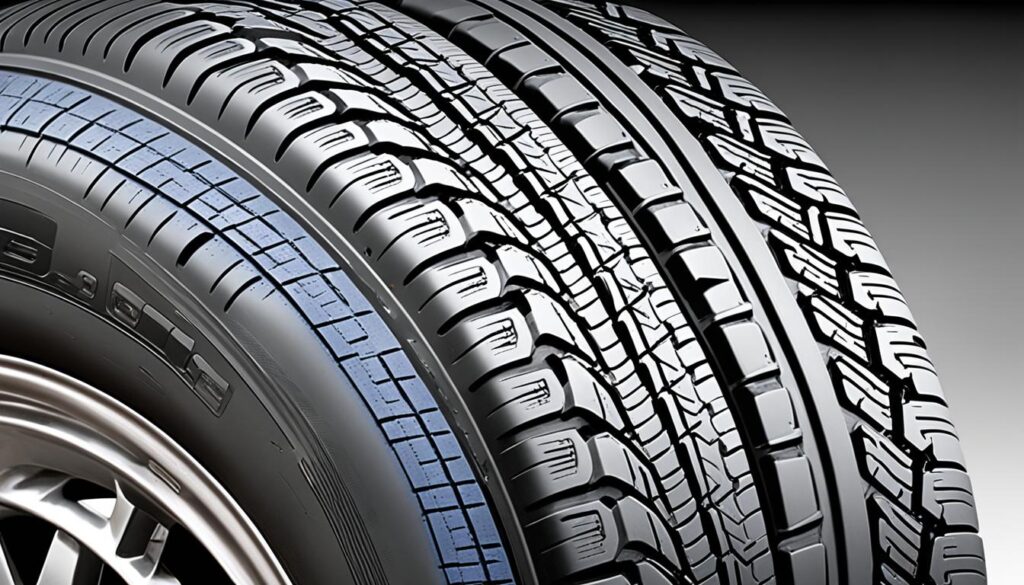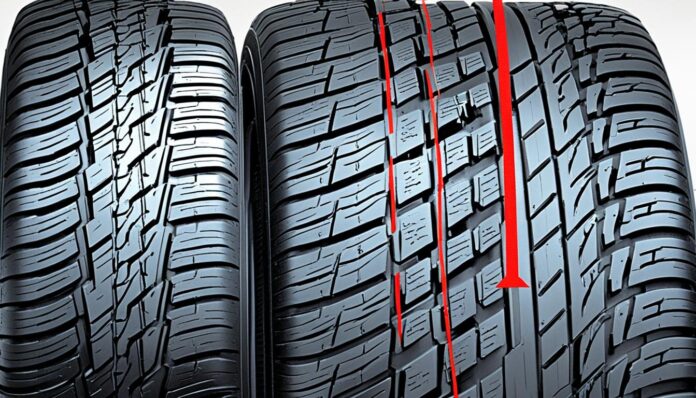As an Amazon Associate, I earn from qualifying purchases
Tire feathering and cupping are two common wear patterns that can affect the performance and longevity of your tires. Feathering is characterized by thinning or fraying of the tread blocks along the edges of the tire, while cupping refers to the formation of small depressions or “cups” on the tire’s surface. These wear patterns can be caused by various factors such as poor alignment, worn suspension components, and road conditions. Understanding and addressing these issues is crucial for maintaining optimal tire performance.
Key Takeaways:
- Tire feathering and cupping are two common wear patterns that can affect tire performance and longevity.
- Feathering is characterized by thinning or fraying of the tread blocks along the edges of the tire, while cupping refers to the formation of small depressions on the tire’s surface.
- Poor alignment, worn suspension components, and road conditions can contribute to tire feathering and cupping.
- Regular tire maintenance, such as balancing, rotation, and alignment checks, can help prevent and resolve these wear patterns.
- Inspecting tire tread depth, checking tire pressure, and replacing tires when necessary are important for prolonging tire life.
Causes and Symptoms of Tire Cupping
Tire cupping is a wear pattern characterized by irregular smooth spots along the treads, either in the center or on the edge of the tire. This condition can be caused by various factors, including:
- Bad wheel bearings
- Bad shocks or suspension components
- Tires that are out of balance
- Tire runout (imperfect roundness)
- Bad alignment
- Low-quality tires
If you are experiencing tire cupping, it is important to recognize the symptoms. These can include:
- Unusual noise while driving
- Worn patches on the tire
- A grinding sound while driving
Ignoring these symptoms can lead to further wear and potential safety hazards. It is essential to consult with a mechanic to address the underlying causes of tire cupping.

| Cause | Symptoms |
|---|---|
| Bad wheel bearings | Noise, vibration |
| Bad shocks or suspension components | Uneven tread wear, bumpy ride |
| Tires out of balance | Vibration at high speeds |
| Tire runout (imperfect roundness) | Noise, vibration |
| Bad alignment | Uneven tire wear, pulling to one side |
| Low-quality tires | Uneven wear, reduced traction |
Addressing the causes of tire cupping and promptly resolving the issue are essential for maintaining tire performance and ensuring safe driving conditions.
Causes and Symptoms of Tire Feathering
Feathering is a wear pattern that occurs when the tread blocks on one side of the tire are more worn than those on the other side, resulting in a feather-like pattern along the edges of the tire. This wear pattern is often caused by two main factors: bad wheel alignment and worn suspension components.
When the wheel alignment is off, the tires are not properly aligned with each other and the road surface. This leads to uneven tire wear, including feathering. Similarly, worn suspension components such as shocks or struts can cause the tire to bounce or wobble, leading to the development of feathering.
Identifying the symptoms of tire feathering is crucial in addressing the issue promptly. Some common symptoms include:
- Reduced grip in wet conditions, which can affect the vehicle’s handling and safety.
- Vibrations or shimmying at certain speeds, which can be felt through the steering wheel or the vehicle itself.
- Decreased handling and performance capabilities, making the vehicle less responsive and stable on the road.
To prevent tire feathering and ensure optimal tire performance, it is essential to address the underlying causes. Regular wheel alignment checks and adjustments can help maintain proper alignment and reduce uneven tire wear. Additionally, inspecting and replacing worn suspension components when necessary can minimize tire feathering.
Note: If you suspect tire feathering, it is recommended to consult a professional mechanic for a thorough inspection and appropriate repairs.

Tire Feathering Causes:
- Bad wheel alignment
- Worn suspension components
Tire Feathering Symptoms:
- Reduced grip in wet conditions
- Vibrations or shimmying at certain speeds
- Decreased handling and performance capabilities
Effects of Tire Feathering and Cupping on Vehicle Performance
Both tire feathering and cupping can have detrimental effects on overall vehicle performance. Understanding these effects is crucial in maintaining optimal driving conditions and ensuring safety on the road.
Tire Feathering Effects
Tire feathering can lead to a variety of negative consequences that impact the handling and performance capabilities of your vehicle. Some of the key effects of tire feathering include:
- Decreased handling: Feathering causes uneven wear on the tire tread, resulting in an imbalance that reduces the vehicle’s stability and maneuverability.
- Reduced grip in wet conditions: Feathered tires have compromised traction, making it challenging to maintain control on wet or slippery surfaces.
- Increased vibrations or shimmying: The uneven tread wear caused by feathering can generate vibrations or shimmying sensations, especially at higher speeds, leading to a less comfortable and stable driving experience.
Tire Cupping Effects
Cupped tires also pose significant risks to vehicle performance and safety. The effects of tire cupping include:
- Reduced grip: Cupping creates irregular smooth spots on the tire surface, diminishing traction and compromising the vehicle’s ability to grip the road.
- Increased wear on other vehicle components: Cupped tires can place additional strain on other parts of the vehicle, such as suspension components, leading to premature wear and potential damage.
- Increased fuel consumption: The uneven wear caused by cupping can result in increased rolling resistance, forcing the engine to work harder and consuming more fuel.
- Increased stopping distance: Cupped tires have reduced traction, necessitating greater effort and distance to bring the vehicle to a complete stop, potentially impacting safety in emergency situations.
It is essential to address both tire feathering and cupping promptly to mitigate these effects and maintain optimal vehicle performance. Regular tire maintenance and proper intervention can help alleviate these problems and ensure a safer and more enjoyable driving experience.
| Effects | Tire Feathering | Tire Cupping |
|---|---|---|
| Decreased handling | ✓ | |
| Reduced grip | ✓ | ✓ |
| Increased fuel consumption | ✓ | |
| Increased stopping distance | ✓ |
Preventing and Resolving Tire Feathering and Cupping
Regular tire maintenance is crucial in preventing and resolving tire feathering and cupping issues. By following these simple tire maintenance tips, you can ensure the longevity and optimal performance of your tires.
Tire Balance:
Having balanced tires is essential for smooth and even wear. Balancing should be done every 3,000 to 6,000 miles or as recommended by the tire manufacturer. This process involves adjusting the weight distribution of the tire and wheel assembly. Balanced tires minimize vibrations and reduce the likelihood of feathering or cupping.
Tire Rotation:
Rotate your tires every 6 months or 6,000 miles to promote even wear on all four tires. This helps prevent feathering and cupping by distributing the forces exerted on the tires more evenly. Refer to your vehicle’s owner manual for the recommended rotation pattern.
Wheel Alignment:
An annual wheel alignment check is essential to prevent feathering and cupping. Proper alignment ensures that the tires are positioned at the optimal angle, reducing uneven wear. If your vehicle pulls to one side or you notice uneven tire wear, it’s important to have the alignment checked and adjusted by a professional.
Tire Inspection:
Regularly inspect your tires for signs of feathering or cupping. Look for uneven wear patterns, irregular smooth spots, or any unusual tire damage. If you detect any issues, it’s important to address them promptly to prevent further damage and potential safety hazards.
Tire Replacement:
If feathering or cupping is detected and cannot be resolved through other maintenance measures, tire replacement may be necessary. Worn tires with significant feathering or cupping may compromise vehicle performance and safety. Consult with a tire professional to determine the appropriate replacement tires for your vehicle.
By following these tire maintenance tips, including regular balancing, rotation, alignment checks, inspections, and timely tire replacement, you can avoid feathering and cupping issues. Taking care of your tires not only prolongs their life but also ensures safe and optimal driving conditions for you and your passengers.
Conclusion
Understanding the differences between tire feathering and cupping is crucial for maintaining tire performance and ensuring safe driving conditions. Regular tire maintenance, including balancing, rotation, and alignment checks, plays a significant role in preventing and resolving these wear patterns. By following these maintenance tips and carrying out proper tire inspections, you can prolong the life of your tires and avoid costly damage.
Proactive tire maintenance not only helps to maintain optimal tire performance but also contributes to safe driving conditions. Regular balancing of the tires helps to distribute weight evenly and prevent uneven wear, while tire rotation promotes more uniform tread wear and extends tire life. Additionally, regular alignment checks ensure that your tires are correctly positioned, reducing the risk of feathering or cupping.
Addressing underlying issues promptly is also essential. If you detect tire feathering or cupping, it is important to determine the root cause and take appropriate action. This may involve replacing the tires, correcting wheel alignment, or addressing worn suspension components. By resolving these issues, you can enhance tire performance, prolong their life, and enjoy a smoother, safer driving experience.
FAQ
What is tire feathering and cupping?
Tire feathering refers to the thinning or fraying of the tread blocks along the edges of the tire, while tire cupping refers to the formation of small depressions or “cups” on the tire’s surface.
What causes tire cupping?
Tire cupping can be caused by various factors such as bad wheel bearings, worn shocks or suspension components, tires that are out of balance, tire runout, bad alignment, or low-quality tires.
What are the symptoms of tire cupping?
Symptoms of tire cupping include unusual noise, worn patches, and a grinding sound while driving.
What causes tire feathering?
Tire feathering is often caused by bad wheel alignment or worn suspension components.
What are the symptoms of tire feathering?
Symptoms of tire feathering include reduced grip in wet conditions, vibrations or shimmying at certain speeds, and decreased handling and performance capabilities.
What are the effects of tire feathering and cupping on vehicle performance?
Both tire feathering and cupping can lead to decreased handling and performance capabilities, reduced grip, increased fuel consumption, and an increase in stopping distance.
How can I prevent and resolve tire feathering and cupping?
Regular tire maintenance, including balancing, rotation, and alignment checks, can help prevent and resolve these wear patterns. It is also important to inspect the tire tread depth seasonally and check the tire pressure monthly.
How often should I balance and rotate my tires?
Tires should be balanced every 3,000 to 6,000 miles and rotated every 6 months or 6,000 miles.
How often should I check my wheel alignment?
Wheel alignment should be checked annually to ensure proper tire wear and performance.
What should I do if I detect feathering or cupping on my tires?
If feathering or cupping is detected, it may be necessary to replace the tires or address specific issues such as wheel alignment or worn suspension components.
